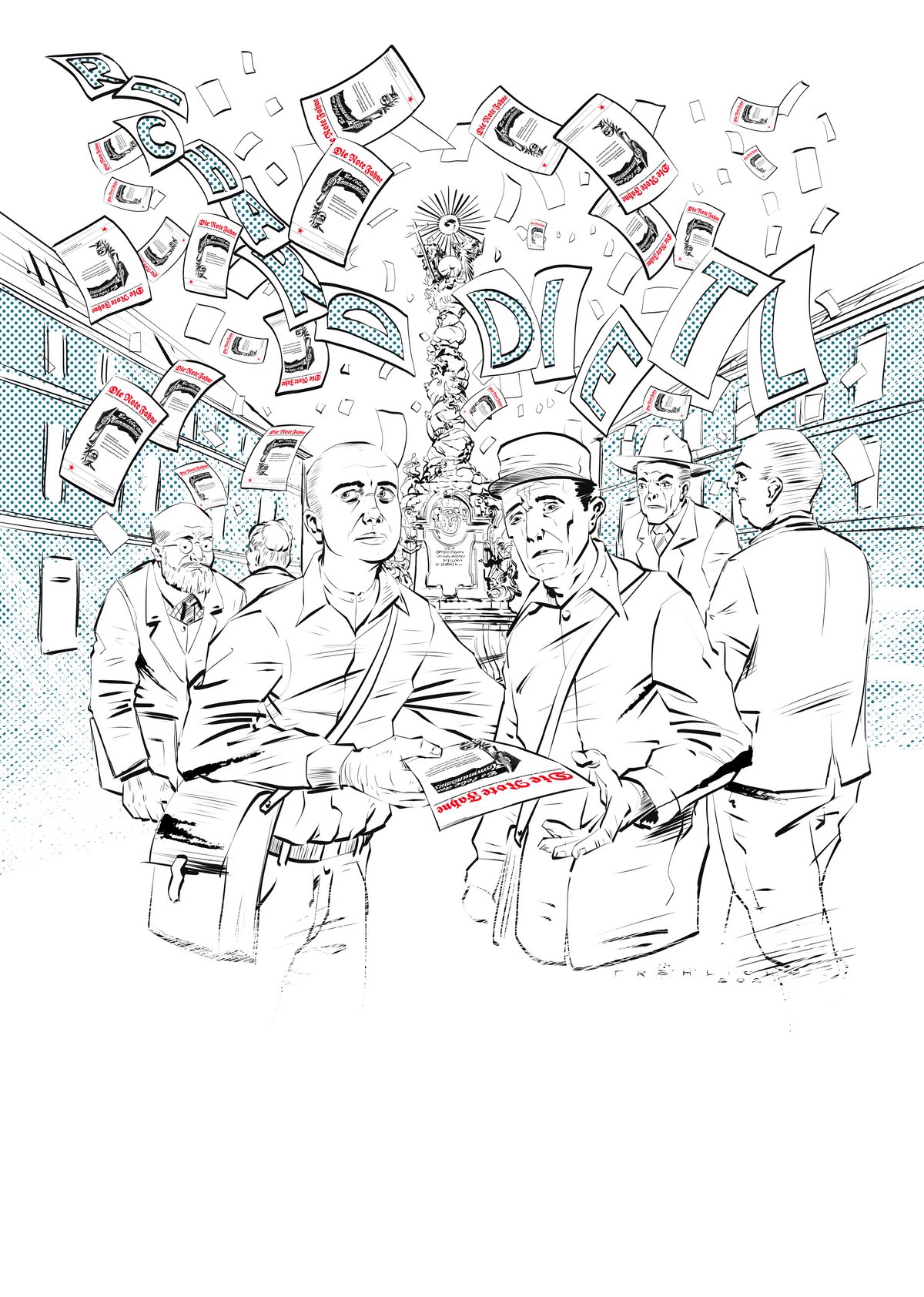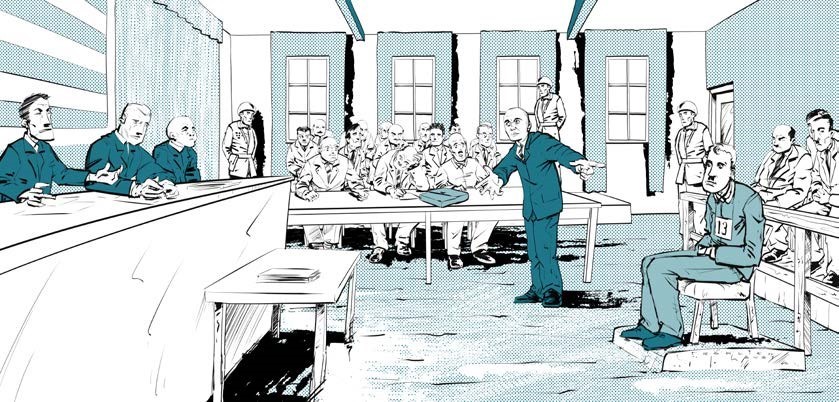In 1938, in a small town in Upper Austria, one of the many Nazi concentration camps was constructed. It was known as the Mauthausen concentration camp. It existed from 1938 to 1945. The camp was run and guarded by the SS. The people who were imprisoned here came from many countries in Europe: Poland, Russia, France, Italy, Germany, Austria and others. They were political opponents, belonged to marginalised groups (e.g. ‘criminals’, ‘asocials’) or were persecuted for anti-Semitic and racist reasons (e.g. Jews). Most of the prisoners were men, but there were also women and children.
In the Mauthausen quarry, the prisoners carried out hard forced labour. In the more than 40 subcamps (Gusen, Steyr, Linz, Ebensee, Vienna...), they were deployed in the arms industry. People lived in overcrowded accommodation. They were not given enough food and clothing, and they starved and died of diseases. SS men beat many prisoners to death, shot them or murdered them in the gas chamber at Mauthausen. In total, almost 200,000 people were imprisoned at Mauthausen and its subcamps. Half of them lost their lives.
The Mauthausen concentration camp was on a hill and could be seen for miles around. Many people were involved with the camp: they worked there, brought deliveries or knew SS men. Almost everyone knew about the death camp. Often, the SS men committed the crimes in full view of the population. On 5 May 1945, the Mauthausen concentration camp was liberated by US troops.
Here, you will read the story of a person who was connected with the Mauthausen concentration camp.
Richard Dietl
Text: Christian Dürr – Illustration: Walter Fröhlich

Richard Dietl is born in Wels, Upper Austria, in 1911. From his early youth, he stands up for the rights of working-class people. At the age of 18, he joins the youth organisation of the Communist Party of Austria. He marries Paula Köpl and begins his professional life as an office worker.
When Austria’s Christian Social government establishes a dictatorship in Austria in 1933, the Communist Party is one of the organisations it bans. Richard Dietl is arrested several times.
With the ‘Anschluss’ (‘Annexation’) of Austria in March 1938, the country becomes part of the Nazi German Reich. Large sections of the population are jubilant, but some people form groups to resist the regime – especially Communists. Richard Dietl is part of one of these resistance groups. He distributes flyers denouncing the Nazi regime.
In September 1944, the group is denounced and arrested by the Gestapo. The women are sent to the Kaplanhof prison in Linz, while the men are transferred to the Mauthausen concentration camp.

Once there, Dietl and his comrades have to line up against the ‘Wailing Wall’. The SS keeps them there for four days and three nights without food or water. They have to relieve themselves in their clothes. SS men repeatedly beat the prisoners. Several times, Dietl is taken for interrogation in the Political Department, where his hands are tied behind his back, and he is hung up from them for minutes at a time. Despite the pain, he doesn’t reveal any information.
At the ‘Wailing Wall’, Richard Dietl has to watch while his best friend Karl Scharrer is beaten so brutally that he dies a few days later. In this moment, it becomes clear to him that he must do everything in his power to survive so that the murderers receive their just punishment.
Dietl and his comrades are assigned to the ‘Strafkompanie’ (‘penal company’) in the quarry. Without shoes on, they have to carry the heavy granite blocks up the ‘stairs of death’ into the camp. One time, when climbing the steep steps, Dietl meets his comrades Karl Schwarzlmüller and Alois Fritz coming the other way. They implore him to pass on a message to their families for them, because they see him as the strongest of the group and therefore likely to survive. Then they say their farewells. After two days in the penal company, twelve comrades are dead – tortured to death or shot.

In late April 1945, Nazi Germany is on the brink of collapse. On 27 April 1945, out of 68 comrades from Richard Dietl’s resistance group, only 34 are still alive in the Mauthausen concentration camp. The Gauleiter (regional leader) of the Upper Danube zone, August Eigruber, orders their execution so that they won’t be able to continue their political activity after the war.
The secret prisoners’ committee in the Mauthausen concentration camp tries to save the resistance fighters. Preparations are made for a night-time escape over the camp fence. But the men are so weakened they can’t muster the strength and will for this dangerous undertaking. When the prisoners are spotted by the guards in the darkness, they run back into their barracks.
The group’s situation is now hopeless. But Richard Dietl refuses to accept his fate. After a sleepless night, he walks up as confidently as he possibly can to the SS man at the gate of the prisoners’ camp. Attention! Cap off! ‘Prisoner 96,969 reporting at the entrance to the stores!’ The SS man looks up and down the list with his finger and can’t find him. ‘When did you go in?’ ‘Quarter of an hour ago, Herr Unterscharführer!’ The SS man checks the list again and still cannot find him. Then he shouts at him. ‘Clear off!’

Dietl is out of the prisoners’ camp but not yet in safety. He goes to the Infirmary Camp, where he hides in Barrack 7. This hut is used to house prisoners with typhoid fever and is avoided by the SS because of the risk of infection. Dietl hides under dead and nearly-dead prisoners for a whole week, until American tanks enter the camp on 5 May 1945. Richard Dietl is free. His comrades, however, were murdered in the gas chamber on the morning of 28 April 1945, a week before the liberation of the camp.

Richard Dietl wants to bear witness to the crimes so that the murderers are punished. Shortly after the liberation his report on the Mauthausen concentration camp is printed in a newspaper. He names both the victims and the perpetrators.
In 1946, Dietl appears as a witness in the first major trial of those are primarily responsible for the crimes in the Mauthausen concentration camp. Among the defendants he faces in the American military tribunal is Eigruber, the former Gauleiter who had sentenced him and his 33 comrades to death one year earlier. Dietl’s testimony plays a significant role in ensuring that Eigruber is convicted by the tribunal and executed in 1947.
Over the following years, Richard Dietl resumes his political work in the Communist Party. He is elected to the council of his home city Wels. He also runs a small tobacconist’s shop.
In 1971, Richard Dietl dies in Wels at the age of 60.
- 1911 Richard Dietls is born in Wels
- 1914 28 July, start of the First World War
- 1918 11 November, end of the First World War
- 1929 He joins the youth organisation of the Communist Party of Austria
- 1933 30 January, Adolf Hitler becomes Reich Chancellor in Germany
- In March, the Christian Social government shuts down the Austrian parliament
- Richard Dietl is arrested on several occasions
- 1938 12 March, ‘Anschluss’ (‘Annexation’) of Austria to Nazi Germany
- 8 August, construction starts on the Mauthausen concentration camp
- Richard Dietl joins a resistance group; he distributes flyers
- 1939 1 September, start of the Second World War
- 1944 The resistance group is denounced; the arrested men are sent to the Mauthausen
- 1945 5 May, Mauthausen concentration camp is liberated by the US Army
- 8 May, Nazi Germany surrenders; end of the Second World War in Europe
- Newspaper report with names of perpetrators and victims
- 1946 Richard Dietl appears as a witness in the first Mauthausen major trial in Dachau
- 1971 Richard Dietls dies in Wels
Zum Weiterdenken ...
In der Biografie erfährst du vom Fluchtversuch Richard Dietls aus dem KZ Mauthausen. Auch heute sind viele Menschen auf der Flucht. Wovor fliehen diese Menschen?
Mit einem Trick gelingt es Richard Dietl, das Häftlingslager zu verlassen. In einer Zeichnung sieht man, wie er sich im Sanitätslager versteckt. Welche Risiken geht er damit ein?
Nach dem Ende des Zweiten Weltkriegs werden viele ehemalige Täter verurteilt, viele werden freigesprochen. Richard Dietl sagt bei den Nachkriegsprozessen gegen einige dieser Männer aus. Was glaubst du: Warum ist es für ihn wichtig, Zeugnis über die Verbrechen abzulegen?
Richard Dietl muss im KZ Mauthausen Granitblöcke über die „Todesstiege“ im Steinbruch schleppen. Während deines Rundgangs an der KZ-Gedenkstätte siehst du den Steinbruch und die Umgebung. Einige der Häuser, die du sehen kannst, standen hier schon während der Lagerzeit. Überlege: Wie könnten die Menschen, die in diesen Häusern lebten, auf die Häftlinge im Steinbruch reagiert haben?